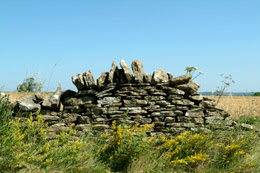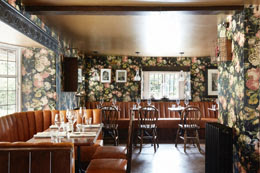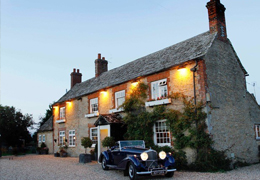 Winter is an interesting time to visit the Cotswolds. The most popular seasons are Spring and Autumn, but Cotswold Hotels have their own special charm in the colder season. Most are monuments to comfort - think of open log fires, excellent food and drink and village locations that make them perfect for a quick exploration of nearby woodland and scenic spots.
Winter is an interesting time to visit the Cotswolds. The most popular seasons are Spring and Autumn, but Cotswold Hotels have their own special charm in the colder season. Most are monuments to comfort - think of open log fires, excellent food and drink and village locations that make them perfect for a quick exploration of nearby woodland and scenic spots.
The Cotswolds has become year-round popular in recent times and more and more local attractions are opening up right through the year - helping to ensure that Cotswold hotels have an ever improving list of options. That said, hoteliers smile a little when guests get so comfortable that they never leave the hotel - often the temptation of a good book is enough for guests seeking perfect relaxation. We’ve noticed how hotels are dropping the books-by-the-yard approach to their bookshelves and are actually creating proper libraries. A trend we like. You’ll also find hot tubs and spas in many hotels and we’ve noticed how many Cotswold hotels happen to be within perfect walking distance of the local pub. Barnsley House hotel have thoughtfully arranged things so that they also own the Village Pub over the road. New member, Artist Residence in Oxfordshire has gone one better by having a very fine pub downstairs (Mr Hanbury’s Mason Arms) Very cosy and hygge, we reckon.
Speaking of hygge, the Scandinavian approach to cosy living in colder weather, we’ve also notes how many of our hotels are adopting ‘Scandi-cool’ interiors. Almost as if they are made for Winter visits. Cotswolds Finest is very proud to welcome two new properties to its collection of Cotswolds Hotels for 2018.
Artist Residence is a terrific smaller property (with just five bedrooms) in the Oxfordshire village of South Leigh. That puts it within easy range of both Oxford and the Cotswolds, perfect for guests from London and the South East looking for Cotswolds hotels. Bedrooms have a fresh and cool design (Instagram fans will be pretty happy here) and this is a pretty chic new option for visitors to the area.
The accommodation is located over and around an Inn, Mr Hanbury’s Mason Arms. Design values are high here too, with Mr Hanbury's Dining Room. It’s basically one of the most atmospheric of dining rooms amongst Cotswolds hotels, with House of Hackney wallpapers and Connor Brothers contemporary art dotted around. Look out for the Andy Doig neons too. When modern design meets historic pub the results can be inspirational and that’s the case here - full of surprises and a welcome addition to our cast of special Cotswolds hotels.
Dining is heavily centred on the Cotswolds location, especially as the chef is a huge fan of foraging.
Local attractions include Burford, the Cotswold Wildlife Park and Blenheim Palace. Or you can keep sightseeing local too with a trip to the local church to see the medieval ‘doom’ paintings. Every year, The Cotswolds runs through a calendar of events both natural and human. The ‘Cotswolds’ season is well established now and any visitor to the area is well-advised to check to see what is happening during their visit. Events are not always on a large scale, but can add a lot to a short break.
Things begin to get interesting in February, with the arrival of snowdrops. Local attractions such as Painswick Rococo and Colesbourne open up for snowdrop viewing, an excuse to get out and about and do a bit of people watching too, ideally over tea and cake. Every Hotel in the Cotswolds will offer St Valentine’s breaks, which are ever-popular and, a little later in March, Cheltenham Festival is another signal that the visitor year has properly begun. The Festival comprises four days of jump racing with the Cheltenham Gold Cup as its climax.
There are festivals dotted around the Cotswolds. We like Chipping Norton Literary Festival, which takes over this small North Cotswold town in late April (26-29th in 2018). It punches above its weight in terms of the names it attracts and is a warm, chatty, friendly event.
In May there are some of the more eccentric events for which the Cotswolds is famous. It’s a good tip to add an extra day at your hotel in the Cotswolds in the last Bank Holiday Monday in May, for example. It’s when you can see both Woolsack Racing in Tetbury (a tribute to the importance of the wool industry in the Cotswolds) and Cheese Rolling, near Gloucester. Both involve steep slopes! The Woolsack races are run up the steep Gumstool Hill in Tetbury, carrying a woolsack. A crowd of 5000 or so pack the town and it’s a entertaining day out. Over at Coopers Hill, near Gloucester, Cheese Rolling is all about catching a Gloucester cheese which is rolled down a hill. It’s a dangerous and hilarious event - unlike anything anywhere else. Hotel breaks in the Cotswolds can really be unique. Most of the Cotswolds are in Gloucestershire and it’s that County that gets most of the attention when the area is considered for hotels in the Cotswolds. Having said that, other counties are important too - especially Oxfordshire.
Oxfordshire has the second greatest Cotswold ‘footprint’ - and some of its biggest attractions. Blenheim Palace is a World Heritage Site, the Cotswold Wildlife Park is a crowd pleaser and some of the villages such as Burford and Lechlade are amongst the most worth-visiting. Plus it’s always good to have Oxford within easy reach.
Oxfordshire hotels in the Cotswolds include the Feathers at Woodstock, which has a kitchen run by Dominic Chapman (of Great British Menu fame) and a remarkable collection of gins, over 450 in fact. The bar was first into the Guinness Book of Records for stocking the greatest variety of gins on the planet and the hotel is a popular one, occupying one side of the market place in the historic town. The gates of Blenheim Palace are a short walk away.
Head out for the day to explore Chipping Norton, great for antique shops, and the nearby Rollright Stones an ancient site with its Kings Men stone circle, King Stone and ‘Whispering Knights’.
 Artist Residence is a new hotel in the Cotswolds - based on an old Inn (Mr Hanbury’s Mason Arms) with just five bedrooms, done to chic design standard.
Artist Residence is a new hotel in the Cotswolds - based on an old Inn (Mr Hanbury’s Mason Arms) with just five bedrooms, done to chic design standard.
It’s great, with a particularly cosy dining room. The walls are embellished with modern art and floral House of Hackney wallpapers. The Inn is in South Leigh, a quiet Oxfordshire village. You can walk up to the ancient church to see the Medieval ‘Doom’ paintings, all very Gothic. This newest of hotels in the Cotswolds is recommended if you’re looking for a bolthole to escape to from London - you leave after work and be here for dinner, easily.
Nearby, you can explore picturesque Burford with it’s single main street leading downhill towards the river. The nearby Barringtons (Great and Little Barrington) are two Cotswold villages that really feel as if they belong in the 1950s - every cottage is a free flower show. Explore Kingham too, with a couple of good pubs and the nearby Daylesford Farm Shop. Daylesford is good for people watching, perhaps a wry smile at the prices and to immerse yourself in the cheese room. The cafe is buzzy and colourful and, again, if you can smile at the prices, an enjoyable place to be. They sell clothes and gardening knick-knackerie on site too. It’s perfect for your inner Marie Antoinette.
Visitors looking for a Cotswolds hotel shouldn’t overlook Oxfordshire.
 Calcot Manor is highly respected amongst luxury Cotswold Hotels. Your children can experience a little luxury too, with a playbarn and OFSTED-inspected nanny on the staff. Nearby Whatley Manor is yet another property with a reputation for doing things ‘right’. There’s Michelin dining and the unusual fact that the hotel has more gardens than guest rooms.
Calcot Manor is highly respected amongst luxury Cotswold Hotels. Your children can experience a little luxury too, with a playbarn and OFSTED-inspected nanny on the staff. Nearby Whatley Manor is yet another property with a reputation for doing things ‘right’. There’s Michelin dining and the unusual fact that the hotel has more gardens than guest rooms.  In pursuit of the luxury Cotswold hotels, take a look at what is happening on Fish Hill, just outside Broadway. Here under private ownership, there are no fewer than 3 private hotels on the same slopes.
In pursuit of the luxury Cotswold hotels, take a look at what is happening on Fish Hill, just outside Broadway. Here under private ownership, there are no fewer than 3 private hotels on the same slopes.  Building styles in the Cotswolds have evolved to fit the landscape and local building materials, a style known as Cotswold vernacular. The buildings with the greatest character, for the visitor today, are surely the farm houses, cottages and manor houses which date from the 16th to 18th centuries. Many hotels in the Cotswolds are from this period, when a great influx of wealth accrued from the staggering success of the local wool trade. Cotswold breed wool attracted high prices in the wool markets of Europe. Hotels in Cotswolds buildings from this time display dormer windows (attic windows essen-tiually), gables, steep pitched stone-slated roofs. Typically Tudor windows continued long after the Elizabethan period because it suited the local build-ing materials and style.
Building styles in the Cotswolds have evolved to fit the landscape and local building materials, a style known as Cotswold vernacular. The buildings with the greatest character, for the visitor today, are surely the farm houses, cottages and manor houses which date from the 16th to 18th centuries. Many hotels in the Cotswolds are from this period, when a great influx of wealth accrued from the staggering success of the local wool trade. Cotswold breed wool attracted high prices in the wool markets of Europe. Hotels in Cotswolds buildings from this time display dormer windows (attic windows essen-tiually), gables, steep pitched stone-slated roofs. Typically Tudor windows continued long after the Elizabethan period because it suited the local build-ing materials and style. It might be surprising that the hotels in the Cotswolds are a great base for exploring aspects of Roman Britain.
It might be surprising that the hotels in the Cotswolds are a great base for exploring aspects of Roman Britain. The Cotswolds are made of limestone, to be specific oolitic limiestone. To geologists it’s calcium carbonate pressed together tightly like fish roe. The ancient greek words that make up ‘oolite’ are for ‘egg’ and ‘stone’. So much for geology, for most visitors the real appeal of limestone is in the colour of a hotel in Cotswolds stone or a row of cottages, as well as the curve of the landscape.
The Cotswolds are made of limestone, to be specific oolitic limiestone. To geologists it’s calcium carbonate pressed together tightly like fish roe. The ancient greek words that make up ‘oolite’ are for ‘egg’ and ‘stone’. So much for geology, for most visitors the real appeal of limestone is in the colour of a hotel in Cotswolds stone or a row of cottages, as well as the curve of the landscape. Cotswold stone, as well as shaping the natural landscape so directly has also dictated the character and form of local buildings. Some oolites form a fine-grained stone which is easy to cut - in fact it can literally be sawn into blocks. This is when it is newly quarried, later it hardens on exposure to the air.
Cotswold stone, as well as shaping the natural landscape so directly has also dictated the character and form of local buildings. Some oolites form a fine-grained stone which is easy to cut - in fact it can literally be sawn into blocks. This is when it is newly quarried, later it hardens on exposure to the air. Winter is an interesting time to visit the Cotswolds. The most popular seasons are Spring and Autumn, but Cotswold Hotels have their own special charm in the colder season. Most are monuments to comfort - think of open log fires, excellent food and drink and village locations that make them perfect for a quick exploration of nearby woodland and scenic spots.
Winter is an interesting time to visit the Cotswolds. The most popular seasons are Spring and Autumn, but Cotswold Hotels have their own special charm in the colder season. Most are monuments to comfort - think of open log fires, excellent food and drink and village locations that make them perfect for a quick exploration of nearby woodland and scenic spots. Artist Residence is a new hotel in the Cotswolds - based on an old Inn (Mr Hanbury’s Mason Arms) with just five bedrooms, done to chic design standard.
Artist Residence is a new hotel in the Cotswolds - based on an old Inn (Mr Hanbury’s Mason Arms) with just five bedrooms, done to chic design standard.  Winter is an interesting time to visit the Cotswolds. The most popular seasons are Spring and Autumn, but Cotswold Hotels have their own special charm in the colder season. Most are monuments to comfort - think of open log fires, excellent food and drink and village locations that make them perfect for a quick exploration of nearby woodland and scenic spots.
Winter is an interesting time to visit the Cotswolds. The most popular seasons are Spring and Autumn, but Cotswold Hotels have their own special charm in the colder season. Most are monuments to comfort - think of open log fires, excellent food and drink and village locations that make them perfect for a quick exploration of nearby woodland and scenic spots. For many years Westonbirt Arboretum led the way in the winter, with an illuminated woodland trail named Enchanted Christmas. The combination of tree shapes and creative lighting is, indeed enchanting. Crowds are huge and it’s a highly recommended event.
For many years Westonbirt Arboretum led the way in the winter, with an illuminated woodland trail named Enchanted Christmas. The combination of tree shapes and creative lighting is, indeed enchanting. Crowds are huge and it’s a highly recommended event. What is the Cotswold drink? Believe the celeb loving national press and it's Champagne. To be fair, a lot of Champagne is drunk at Cotswolds hotels, not least during Cheltenham Festival's Gold Cup week.
What is the Cotswold drink? Believe the celeb loving national press and it's Champagne. To be fair, a lot of Champagne is drunk at Cotswolds hotels, not least during Cheltenham Festival's Gold Cup week. Years ago, the only local spirit for Cotswolds hotels to stock was initially a semi mythical Gloucestershire whisky which was actually blended in Scotland for the village of Oldbury. You can still buy it and it is well reviewed.
Years ago, the only local spirit for Cotswolds hotels to stock was initially a semi mythical Gloucestershire whisky which was actually blended in Scotland for the village of Oldbury. You can still buy it and it is well reviewed. For many, Autumn is the best time to stay at cotswolds hotels and inns. The area has an arboretum at each 'end' and, in between, plenty of wide open spaces with Cotswold Beech trees taking star billing. If you plan a visit to the area from late September onward you should be guaranteed a display of tree colour. And there's always the prospect of a good pub or afternoon tea at one of the many cotswolds hotels and inns at the end of a long walk - meanwhile there's a nip in the air and the crunch of leaves underfoot. Rather romantic actually.
For many, Autumn is the best time to stay at cotswolds hotels and inns. The area has an arboretum at each 'end' and, in between, plenty of wide open spaces with Cotswold Beech trees taking star billing. If you plan a visit to the area from late September onward you should be guaranteed a display of tree colour. And there's always the prospect of a good pub or afternoon tea at one of the many cotswolds hotels and inns at the end of a long walk - meanwhile there's a nip in the air and the crunch of leaves underfoot. Rather romantic actually. If you're even just mildly adventurous there's no real need to join the crowds at the area's large scale Autumn attractions. There's a walk that the locals love from every Cotswold village - ask at reception desks in Cotswolds hotels and inns around, check at local tourist information centres or bring the subject up in the pub and you'll benefit from local knowledge.
If you're even just mildly adventurous there's no real need to join the crowds at the area's large scale Autumn attractions. There's a walk that the locals love from every Cotswold village - ask at reception desks in Cotswolds hotels and inns around, check at local tourist information centres or bring the subject up in the pub and you'll benefit from local knowledge.